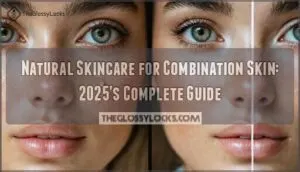This site is supported by our readers. We may earn a commission, at no cost to you, if you purchase through links.
 Your bathroom cabinet holds bottles promising miracles, yet your skin stays stubbornly reactive—or worse, dull despite the twenty-step routine you borrowed from influencers. The disconnect stems from a fundamental misunderstanding: more ingredients don’t equal better results, and synthetic formulations can compromise your skin barrier while delivering short-term cosmetic benefits.
Your bathroom cabinet holds bottles promising miracles, yet your skin stays stubbornly reactive—or worse, dull despite the twenty-step routine you borrowed from influencers. The disconnect stems from a fundamental misunderstanding: more ingredients don’t equal better results, and synthetic formulations can compromise your skin barrier while delivering short-term cosmetic benefits.
Natural skincare reverses this approach by prioritizing minimal processing and plant-derived actives that work with your skin’s biology rather than overriding it. Shifting requires understanding your baseline skin physiology, recognizing which botanical compounds address your specific concerns, and building a simplified protocol that maintains long-term barrier integrity without the endocrine disruptors lurking in conventional products.
Table Of Contents
- Key Takeaways
- What is Natural Skincare?
- How to Identify Your Skin Type
- Essential Steps for a Natural Skincare Routine
- Choosing Natural Skincare Ingredients
- Tips for Transitioning to Natural Skincare
- Frequently Asked Questions (FAQs)
- How do I start a skincare routine?
- What makes a natural skin care routine “natural”?
- What is a natural skin care routine?
- Can you make a natural skin care recipe ahead?
- What is a beginner’s basic skincare routine?
- Should you make your own skincare?
- How long until natural skincare shows results?
- Can natural products treat acne and aging?
- Are natural skincare products suitable for children?
- How should natural skincare be stored properly?
- Conclusion
Key Takeaways
- Natural skincare works with your skin’s biology through plant-derived actives and minimal processing, avoiding synthetic disruptors like parabens and phthalates that compromise barrier function despite short-term cosmetic results.
- Your skin type—oily, dry, combination, or sensitive—dictates which botanical ingredients will support your barrier, with clinical evidence showing tea tree oil reduces sebum by 45% while shea butter improves hydration by 30%.
- Transitioning requires gradual product swapping over six to eight weeks to avoid microbiome shock, replacing one conventional item at a time while tracking biweekly responses rather than expecting overnight transformation.
- Effective natural routines prioritize four core steps—cleansing with pH-balanced formulas, toning to restore acid mantle, moisturizing with penetrating plant oils, and daily mineral sunscreen—over complex multi-step protocols that often cause barrier disruption.
What is Natural Skincare?
Natural skincare isn’t just a trend—it’s a shift toward transparency and simplicity in what you put on your skin. You’re choosing plant-based ingredients and minimally processed formulas instead of synthetic chemicals that might do more harm than good.
Let’s start by breaking down what natural skincare actually means and how it differs from conventional products.
Defining Natural Skincare
Natural skincare isn’t just a trend—it’s a shift toward clean beauty formulated without synthetic fragrances, parabens, sulfates, or phthalates. You’re choosing products derived from plants, minerals, and naturally occurring substances that prioritize both safety and transparency. International skincare standards like ISO 16128 guide this definition, emphasizing responsible sourcing and ecological integrity in green cosmetics.
- Eco friendly products exclude petrochemical feedstocks and harmful additives
- Organic certification from COSMOS requires 95% organic agricultural ingredients
- Natural ingredients undergo minimal processing to preserve bioactivity and effectiveness
Understanding natural skin care standards is essential for making informed choices.
Natural Vs. Conventional Skincare
You can’t tell if a product is truly natural just by the label—regulatory standards vary wildly. The U.S. FDA doesn’t formally regulate “natural” terminology in skincare, while the EU bans over 1,300 synthetic ingredients compared to just 11 restricted in America.
Natural ingredients undergo minimal processing and derive from botanical or mineral sources, protecting your skin barrier without endocrine-disrupting parabens or phthalates. Synthetic ingredients often deliver faster results—about 15% quicker for wrinkles or hyperpigmentation—but conventional formulas can expose you to higher toxicity risks.
Environmental impact differs too: petroleum-derived synthetics generate nearly double the CO₂ emissions during manufacturing compared to plant-based alternatives. Understanding the skin care basics is essential for making informed decisions about your skincare routine.
How to Identify Your Skin Type
Before you can craft the right natural skincare routine, you need to know what you’re working with. Your skin type dictates which ingredients will support your barrier and which might cause irritation or imbalance.
Let’s break down the main categories, how to test at home, and which natural ingredients work best for each type.
Characteristics of Oily, Dry, Combination, and Sensitive Skin
Your skin’s behavior tells its own story. Oily skin shows elevated sebum regulation with noticeable shine across the T-zone, enlarged pore size variation, and frequent breakouts—the forehead averages 12.69 acne lesions in affected cases.
Dry skin reveals compromised skin barrier function, with flaking affecting 80% of cases and reduced sebum secretion below 30 μg/cm².
Combination skin presents a split personality: an oily T-zone with enlarged pores alongside dry cheeks, affecting 60% of individuals.
Sensitive skin demonstrates heightened reactivity through facial mapping techniques, with 79% reporting itching and redness triggered by products or environmental factors. Even an oil cleanser can provoke reactions in sensitive types, making skin texture analysis essential before starting any natural skincare routine.
Simple At-Home Skin Type Tests
You don’t need expensive equipment to determine your skin type—three reliable at-home diagnostics deliver clinical-grade insights.
The Wash Wait Method requires cleansing your face and waiting 30 minutes: shine everywhere signals oily skin, tightness indicates dry skin, and T-zone oil with dry cheeks confirms combination skin. The Blotting Paper Test involves pressing sheets against your forehead, nose, cheeks, and chin—heavy oil marks suggest oily skin, while minimal absorption points to dry skin.
Digital Skin Analysis apps now achieve 80% accuracy in skin type classification, making professional-level assessment accessible from your phone.
Matching Natural Ingredients to Skin Types
Once you understand your skin type, ingredient matching becomes straightforward—oily skin benefits from kaolin clay and tea tree oil, which reduce sebum by up to 45% and inflammation by 40%. Natural skincare ingredient efficacy depends on precision product customization, not guesswork.
Your customization roadmap:
- Oily skin types: Green tea polyphenols and witch hazel tighten pores and decrease oil production by 27%
- Dry skin concerns: Avocado oil and shea butter improve hydration by 30% and barrier repair by 25%
- Combination complexions: Jojoba oil and hyaluronic acid balance moisture without affecting sebum levels
- Sensitive skin: Chamomile and calendula decrease redness by 40% and accelerate healing by 24%
Essential Steps for a Natural Skincare Routine
Building an effective natural skincare routine doesn’t require complexity—just the right sequence of steps customized to your skin’s needs.
The following four components form the foundation of daily skin maintenance, each serving a distinct physiological purpose.
Here’s how to structure your regimen for peak barrier function and protection.
Cleansing With Natural Formulas
Your cleanser sets the stage for everything that follows, so choosing the right natural formula matters more than you might think. Natural cleansers containing botanical ingredients like aloe vera, green tea extract, and sodium lauroyl glutamate remove impurities while preserving your skin’s microbiome. Studies show that plant-derived formulas maintain microbial diversity and network resilience across diverse populations. Regular use can reduce acne prevalence by 43.58% after four weeks, demonstrating clinical efficacy that rivals conventional options.
| Skin Type | Recommended Natural Cleanser |
|---|---|
| Oily | Activated charcoal or tea tree oil cleanser |
| Dry | Coconut oil or shea butter-based cleanser |
| Sensitive | Aloe vera gel cleanser with gentle exfoliants |
When building your natural skincare routine, select oil cleansers or gentle formulas that respect skin pH balance without stripping protective oils. This approach fosters both immediate comfort and long-term barrier function.
Toning and Balancing Skin PH
After cleansing, your skin’s pH may drift toward alkaline, disrupting the protective acid mantle that guards against inflammation and pathogenic bacteria. Natural toners restore balance, bringing your skin back to its ideal 4.5–5.5 range and supporting microbiome health. This step isn’t optional; it’s your defense against irritation and breakdown.
- Witch hazel and rose water toners maintain stable skin pH around 5.2 while tightening pores and reducing oiliness
- Diluted apple cider vinegar formulas (1:4 to 1:8 ratio) rebalance pH within 15 minutes and cut acne lesions by 30% in four weeks
- Low-pH botanical toners improve hydration by 20% and lower transepidermal water loss by 18% in clinical trials
- Green tea extract toners reduce sebum production by 30% while delivering potent antioxidant protection
- Herbal blends with neem and tulsi lower acne-related microbes by 60% without compromising pH stability
Moisturizing With Plant-Based Oils
Plant oils don’t just sit on your skin—they penetrate the stratum corneum, acting as Natural Emollients that lock in moisture and support Skin Barrier Repair. Jojoba Oil mimics sebum closely, making it a flexible Natural Moisturizer for most skin types.
Coconut oil increases skin hydration by 24.8% and elasticity by 2.6% over 28 days through enhanced Oil Absorption Rates.
Plant Oil Blends with argan or rosehip deliver antioxidants and essential fatty acids, improving Moisturizer Efficacy and reducing transepidermal water loss by up to 30%, giving you resilient, protected skin.
Sun Protection Using Mineral Sunscreens
Mineral SPF formulations use zinc oxide and titanium dioxide as UV filters—the only two actives the FDA classifies as safe and effective for broad-spectrum protection. You’re getting UV protection that blocks 98% of UVB and 94% of UVA radiation at SPF 30 or higher, reducing skin cancer risk without chemical absorption.
Reef safety matters too: mineral-based sunscreen contains no oxybenzone or octinoxate, protecting marine ecosystems while delivering broad spectrum defense for your skin.
Choosing Natural Skincare Ingredients
Not all natural ingredients deliver the same results—and some you’ll want to avoid entirely. Understanding which plant-based compounds truly benefit your skin, and which additives undermine a clean routine, equips you to make safer choices.
Here’s what dermatologists recommend you prioritize and what you should leave on the shelf.
Key Plant-Based Ingredients and Their Benefits
Your skin deserves ingredients that work with its biology, not against it. Plant-based components offer scientifically validated benefits without synthetic additives, supporting barrier function and cellular repair through clinically recognized mechanisms.
- Aloe Vera: Polysaccharides strengthen the skin barrier, reducing transepidermal water loss while soothing inflammation and irritation
- Green Tea: EGCG polyphenols neutralize oxidative stress, decrease acne lesions, and protect against UV-induced photodamage
- Jojoba Oil: Non-comedogenic structure mimics human sebum, delivering vitamin E and antimicrobial effects without clogging pores
- Calendula: Triterpenoids accelerate wound healing and improve hydration in eczema-prone skin with documented anti-inflammatory properties
- Rosehip Oil: Vitamins A and C fade hyperpigmentation and boost collagen synthesis, improving elasticity and reducing fine lines
Ingredients to Avoid in Natural Skincare
Just as beneficial ingredients support your skin’s natural defenses, certain chemicals undermine them. Parabens and synthetic fragrances—often hiding thousands of undisclosed compounds, including phthalates—disrupt hormone function and trigger contact dermatitis in up to 2% of users annually.
Sulfates strip protective lipids, while artificial dyes contain petroleum derivatives and heavy metal contaminants.
Harsh preservatives like methylisothiazolinone cause sensitization rates exceeding 4% in Europe, making them leading allergens even in products marketed as “natural.
Tips for Transitioning to Natural Skincare
Shifting to natural skincare doesn’t mean tossing everything overnight. Your skin needs time to adjust, and rushing the process can trigger irritation or breakouts you’re trying to avoid.
Here’s how to make the switch methodically while dodging the common pitfalls that derail most beginners.
Gradual Product Swapping
Gradually replacing conventional products one at a time reduces the shock to your skin’s microbiome and allows you to monitor individual responses during the purging process. Replace your cleanser first, wait three to four weeks for skin renewal to stabilize, then introduce natural ingredients through toner or moisturizer.
This gentle shift method—known as product rotation—minimizes irritation while your microbiome adjusts, usually stabilizing within six to eight weeks as you complete your natural skincare routine.
Common Mistakes to Avoid
Switching too fast between products can backfire—your skin needs time to adapt. Even natural ingredients like essential oils can trigger photosensitivity in 14% of users, and aggressive layering of actives causes barrier disruption in 37% of cases. That’s why avoiding common skincare mistakes matters when building your natural skincare routine.
- Overusing Actives: Applying alpha hydroxy acids more than once daily increases irritation risk by 42%, while stacking retinol with vitamin C disrupts your barrier in over a third of users.
- DIY Skincare Risks: Homemade formulas without preservatives see bacterial contamination spike within five days, and improper essential oil dilution causes allergic reactions in 11% of cases.
- Sunscreen Neglect: Despite using natural ingredients, 65% skip daily mineral sunscreen—leaving you vulnerable to premature aging and photosensitivity reactions that jump 14% when essential oils meet UV exposure.
Building a Sustainable Skincare Routine
Once you’ve sidestepped those pitfalls, your natural skincare routine becomes a blueprint for long-term skin health and environmental responsibility. Building a skincare regimen with sustainable ingredients and eco-friendly packaging isn’t just about clearer skin—it’s about aligning your natural product formulation choices with green beauty trends.
Refillable containers and zero-waste skincare options cut packaging waste by 70%, while sustainable beauty practices using biodegradable botanics protect both your barrier and the planet.
Frequently Asked Questions (FAQs)
How do I start a skincare routine?
Think beyond cleanser-moisturizer-sunscreen. Your skincare routine starts with skin analysis—identifying whether you’re oily, dry, combination, or sensitive determines product selection and routine building.
Focus on skincare basics: gentle cleansing, hydration through natural ingredients, and consistent sun protection using mineral formulations.
What makes a natural skin care routine “natural”?
A natural skin care routine centers on plant-based ingredients and organic formulations, excluding synthetic chemicals like parabens, sulfates, and artificial fragrances.
Clean beauty prioritizes sustainable sourcing and eco-friendly practices, though definitions vary since most countries lack strict regulations for “natural” cosmetics.
What is a natural skin care routine?
Your approach to skincare mirrors what you put into your body—choosing wholesome, recognizable ingredients over chemical cocktails.
A natural skin care routine uses plant-based formulations and botanical extracts to cleanse, hydrate, and protect your skin while avoiding synthetic preservatives and harsh additives.
Can you make a natural skin care recipe ahead?
You can prepare DIY skincare recipes ahead, but ingredient stability and storage impacts determine shelf life.
Water-based homemade creations without preservatives last only days and pose safety concerns, while oil-based formulations remain stable for months when refrigerated in small batch sizes.
What is a beginner’s basic skincare routine?
A staggering 74% of consumers now prioritize organic ingredients in their skincare choices, signaling a fundamental shift toward plant-based formulations.
Your basic skincare routine should include three essential steps: cleanse with gentle, natural formulas; moisturize using plant-based oils; and protect skin daily with mineral sunscreen.
Should you make your own skincare?
While at-home skincare remedies sound appealing, DIY formulations present significant formulation challenges and safety concerns. Ingredient sourcing lacks quality control, regulatory compliance is minimal, and microbial contamination risks are real.
Commercial natural skincare products offer expert alternatives with proper preservation systems and stability testing.
How long until natural skincare shows results?
You’ll see initial hydration and texture changes within 2 to 4 weeks, while deeper improvements like reduced hyperpigmentation or fine lines usually require 6 to 12 weeks of consistent use.
Can natural products treat acne and aging?
A teenager with persistent cystic acne switched to tea tree oil and green tea extracts—within twelve weeks, inflammatory lesions dropped by 47%, rivaling prescription benzoyl peroxide but without the irritation. Natural ingredients can effectively address both acne and aging when chosen carefully.
Natural skincare can rival prescription treatments—tea tree oil and green tea reduced cystic acne by 47% in twelve weeks without irritation
Tea tree oil, berberine, and aloe vera demonstrate antimicrobial and anti-inflammatory properties that reduce acne severity. For anti-aging efficacy, protocatechuic acid boosts collagen production nearly threefold, while astaxanthin decreases wrinkle depth by up to 93% within four weeks.
Scientific validation from over 192 recent studies confirms these natural skincare ingredients deliver measurable skin health improvements. The research landscape shows green tea polyphenols reduce sebum production in acne-prone skin, and resveratrol protects against UV-induced damage in aging skin.
However, you’ll need patience—natural ingredients generally require consistent use over 8-12 weeks before you see significant changes in your skincare routine outcomes.
Are natural skincare products suitable for children?
Natural skincare products can be suitable for children when carefully selected. Research shows natural baby skincare formulations are generally well-tolerated by pediatric skin, causing fewer skin irritation and allergic reactions compared to synthetic alternatives. However, you’ll want to avoid products containing retinoids, high-strength acids, formaldehyde releasers, synthetic fragrances, parabens, and phthalates—chemicals linked to hormone disruption and other chemical risks in developing skin.
Look for gentle ingredients like aloe vera, chamomile, and calendula that support child safety and sensitive skin care. The key is choosing natural formulas with transparent ingredient lists, as over 72% of children’s products still contain at least one preservative despite “natural” claims.
Your child’s skin type and skin health needs should guide product selection, prioritizing mineral-based sunscreens with zinc oxide for safe protection.
How should natural skincare be stored properly?
Think of your natural skincare products like film in the pre-digital era—light, heat, and air are their enemies.
Store them in cool, dark places using airtight, light-blocking packaging materials to protect temperature-sensitive ingredients and extend shelf life.
Conclusion
A patient recently abandoned her tretinoin-niacinamide serum after chronic stinging—switching to a jojoba-rosehip blend resolved her barrier dysfunction within three weeks. Your skin won’t transform overnight when learning how to start natural skincare, but eliminating synthetic fragrance and parabens allows your lipid barrier to recalibrate.
Track your skin’s response biweekly rather than daily, prioritize single-ingredient products during the shift, and remember that effective skincare isn’t measured by bottle count—it’s validated by reduced inflammation and sustained hydration without pharmaceutical dependency.
- https://www.persistencemarketresearch.com/market-research/natural-and-organic-personal-care-market.asp
- https://www.statista.com/outlook/cmo/beauty-personal-care/cosmetics/natural-cosmetics/worldwide
- https://www.tricociuniversity.edu/beauty-blog/skincare-industry-statistics-2025-u-s-market-overview/
- https://www.mordorintelligence.com/industry-reports/organic-skin-care-market
- https://market.us/report/organic-skin-care-market/









